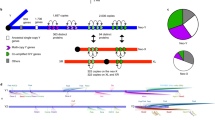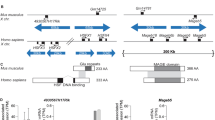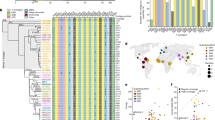Abstract
Most genes in the human NRY (non-recombining portion of the Y chromosome) can be assigned to one of two groups: X-homologous genes or testis-specific gene families with no obvious X-chromosomal homologues1,2. The CDY genes have been localized to the human Y chromosome1, and we report here that they are derivatives of a conventional single-copy gene, CDYL (CDY-like), located on human chromosome 13 and mouse chromosome 6. CDY genes retain CDYL exonic sequences but lack its introns. In mice, whose evolutionary lineage diverged before the appearance of the Y-linked derivatives, the autosomal Cdyl gene produces two transcripts; one is expressed ubiquitously and the other is expressed in testes only. In humans, autosomal CDYL produces only the ubiquitous transcript; the testis-specific transcript is the province of the Y-borne CDY genes. Our data indicate that CDY genes arose during primate evolution by retroposition of a CDYL mRNA and amplification of the retroposed gene. Retroposition contributed to the gene content of the human Y chromosome, together with two other molecular evolutionary processes: persistence of a subset of genes shared with the X chromosome3,4 and transposition of genomic DNA harbouring intact transcription units5.
This is a preview of subscription content, access via your institution
Access options
Subscribe to this journal
Receive 12 print issues and online access
$209.00 per year
only $17.42 per issue
Buy this article
- Purchase on Springer Link
- Instant access to full article PDF
Prices may be subject to local taxes which are calculated during checkout





Similar content being viewed by others
References
Lahn, B.T. & Page, D.C. Functional coherence of the human Y chromosome. Science 278, 675– 680 (1997).
Vogt, P.H. et al. Report of the Third International Workshop on Y chromosome mapping 1997. Cytogenet. Cell Genet. 79, 1–20 (1997).
Graves, J.A.M. The origin and function of the mammalian Y chromosome and Y-borne genes—an evolving understanding. BioEssays 17, 311 –321 (1995).
Jegalian, K. & Page, D.C. A proposed path by which genes common to mammalian X and Y chromosomes evolve to become X inactivated. Nature 394, 776–780 ( 1998).
Saxena, R. et al. The DAZ gene cluster on the human Y chromosome arose from an autosomal gene that was transposed, repeatedly amplified and pruned. Nature Genet. 14, 292– 299 (1996).
Vollrath, D. et al. The human Y chromosome: a 43-interval map based on naturally occurring deletions. Science 258, 52– 59 (1992).
De Bry, R.W. & Seldin, M.F. Human/mouse homology relationships. Genomics 33, 337–351 (1996).
Yen, P.H., Chai, N.N. & Salido, E.C. The human autosomal gene DAZLA: testis specificity and a candidate for male infertility. Hum. Mol. Genet. 5, 2013–2017 (1996).
Shan, Z. et al. A SPGY copy homologous to the mouse gene Dazla and the Drosophila gene boule is autosomal and expressed only in the human male gonad. Hum. Mol. Genet. 5, 2005–2011 (1996).
Cooke, H.J., Lee, M., Kerr, S. & Ruggiu, M. A murine homologue of the human DAZ gene is autosomal and expressed only in male and female gonads. Hum. Mol. Genet. 5, 513– 516 (1996).
Reijo, R. et al. Mouse autosomal homolog of DAZ, a candidate male sterility gene in humans, is expressed in male germ cells before and after puberty. Genomics 35, 346–352 (1996).
Ganguly, R., Swanson, K.D., Ray, K. & Krishnan, R. A BamHI repeat element is predominantly associated with the degenerating neo-Y chromosome of Drosophila miranda but absent in the Drosophila melanogaster genome. Proc. Natl Acad. Sci. USA 89, 1340–1344 (1992).
Steinemann, M. & Steinemann, S. Degenerating Y chromosome of Drosophila miranda: a trap for retroposons. Proc. Natl Acad. Sci. USA 89, 7591– 7595 (1992).
Steinemann, M. & Steinemann, S. The enigma of Y chromosome degeneration: TRAM, a novel retrotransposon is preferentially located on the Neo-Y chromosome of Drosophila miranda. Genetics 145, 261–266 ( 1997).
Eicher, E.M., Hutchison, K.W., Phillips, S.J., Tucker, P.K. & Lee, B.K. A repeated segment on the mouse Y chromosome is composed of retroviral-related, Y-enriched and Y-specific sequences. Genetics 122, 181–192 (1989).
Charlesworth, B., Sniegowski, P. & Stephan, W. The evolutionary dynamics of repetitive DNA in eukaryotes. Nature 371, 215–220 (1994).
Gyapay, G. et al. A radiation hybrid map of the human genome. Hum. Mol. Genet. 5, 339–346 ( 1996).
Hudson, T.J. et al. An STS-based map of the human genome. Science 270, 1945–1954 ( 1995).
Burge, C. & Karlin, S. Prediction of complete gene structures in human genomic DNA. J. Mol. Biol. 268, 78–94 (1997).
Novacek, M.J. Mammalian phylogeny: shaking the tree. Nature 356, 121–125 (1992).
Kumar, S. & Hedges, S.B. A molecular timescale for vertebrate evolution. Nature 392, 917– 920 (1998).
Pilbeam, D. The descent of hominoids and hominids. Sci. Am. 250 , 84–96 (1984).
Ohno, S. Sex Chromosomes and Sex-linked Genes (Springer-Verlag, Berlin, 1967).
Watson, J.M., Spencer, J.A., Riggs, A.D. & Graves, J.A. Sex chromosome evolution: platypus gene mapping suggests that part of the human X chromosome was originally autosomal. Proc. Natl Acad. Sci. USA 88, 11256–11260 ( 1991).
Foster, J.W. & Graves, J.A. An SRY-related sequence on the marsupial X chromosome: implications for the evolution of the mammalian testis-determining gene. Proc. Natl Acad. Sci. USA 91, 1927 –1931 (1994).
Acknowledgements
We thank H. Skaletsky and F. Lewitter for assistance with sequence analysis; the San Diego Zoo and the Duke Primate Center for animal specimens; and P. Bain, A. Bortvin, L. Brown, C. Burge, B. Charlesworth, A. Chess, S. Gilbert, R. Jaenisch, T. Kawaguchi, K. Kleene, D. Menke, R. Saxena, C. Sun, C. Tilford and J. Wang for helpful discussions and comments on the manuscript.
Author information
Authors and Affiliations
Corresponding author
Rights and permissions
About this article
Cite this article
Lahn, B., Page, D. Retroposition of autosomal mRNA yielded testis-specific gene family on human Y chromosome. Nat Genet 21, 429–433 (1999). https://doi.org/10.1038/7771
Received:
Accepted:
Issue Date:
DOI: https://doi.org/10.1038/7771
This article is cited by
-
Cdyl2-60aa encoded by CircCDYL2 accelerates cardiomyocyte death by blocking APAF1 ubiquitination in rats
Experimental & Molecular Medicine (2023)
-
Chromodomain on Y-like 2 (CDYL2) implicated in mitosis and genome stability regulation via interaction with CHAMP1 and POGZ
Cellular and Molecular Life Sciences (2023)
-
Epigenetic Regulation of Spermatogonial Stem Cell Homeostasis: From DNA Methylation to Histone Modification
Stem Cell Reviews and Reports (2021)
-
High frequencies of Non Allelic Homologous Recombination (NAHR) events at the AZF loci and male infertility risk in Indian men
Scientific Reports (2019)
-
Germline deletion of Cdyl causes teratozoospermia and progressive infertility in male mice
Cell Death & Disease (2019)



